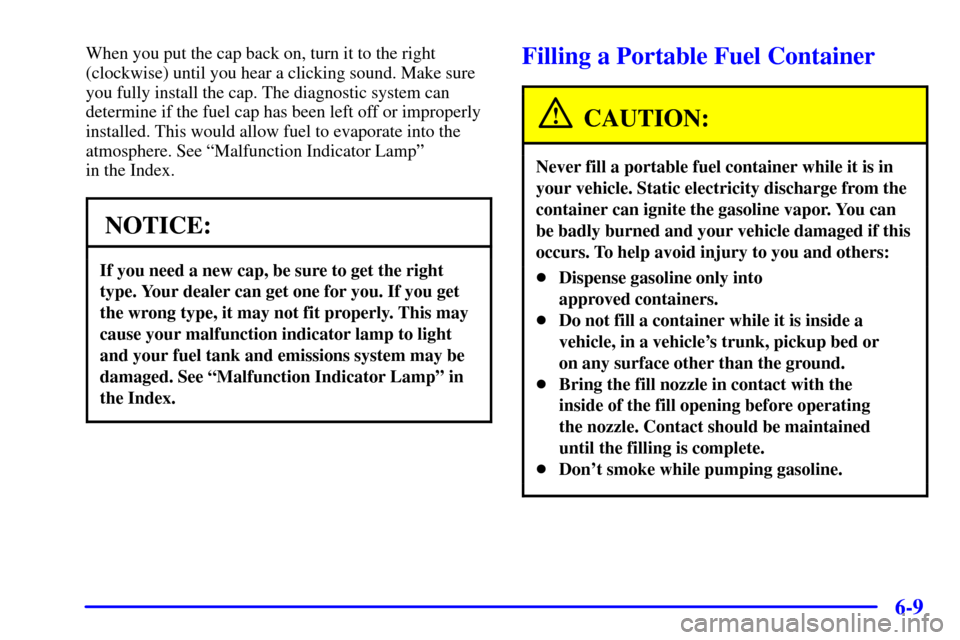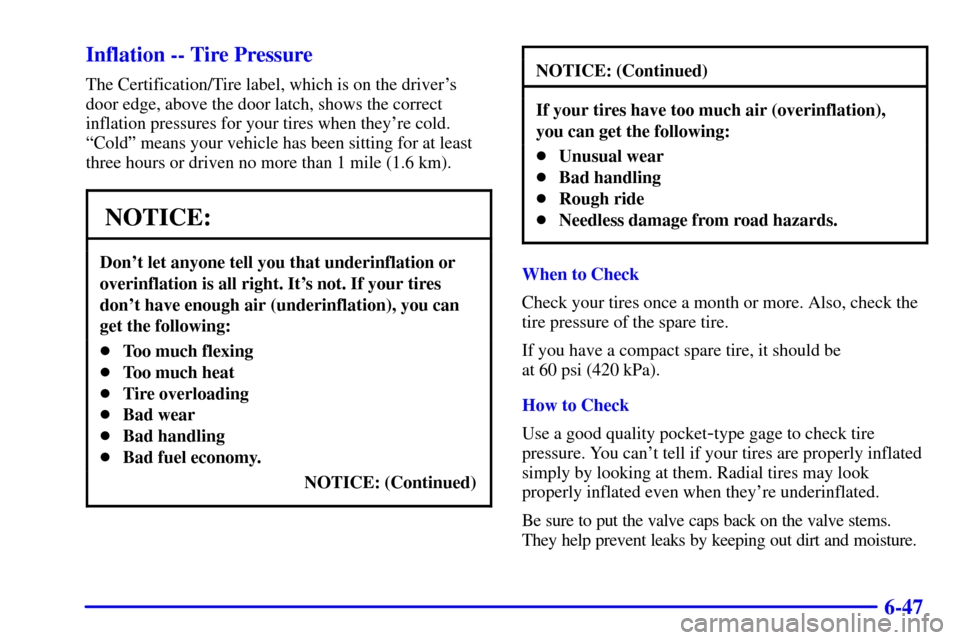Page 272 of 407
6-7
Fuels in Foreign Countries
If you plan on driving in another country outside the
United States or Canada, the proper fuel may be hard
to find. Never use leaded gasoline or any other fuel not
recommended in the previous text on fuel. Costly repairs
caused by use of improper fuel wouldn't be covered by
your warranty.
To check on fuel availability, ask an auto club, or
contact a major oil company that does business in the
country where you'll be driving.
Filling Your Tank
CAUTION:
Fuel vapor is highly flammable. It burns
violently, and that can cause very bad injuries.
Don't smoke if you're near fuel or refueling
your vehicle. Keep sparks, flames and smoking
materials away from fuel.
The fuel cap is behind a hinged door on the driver's side
of your vehicle.
Page 273 of 407
6-8
While refueling, hang the cap by the tether from
the hook on the fuel filler door.
To remove the cap, turn it slowly to the
left (counterclockwise). The cap has a spring
in it; if you let go of the cap too soon, it will spring
back to the right.
CAUTION:
If you get fuel on yourself and then something
ignites it, you could be badly burned. Fuel can
spray out on you if you open the fuel filler cap
too quickly. This spray can happen if your tank
is nearly full, and is more likely in hot weather.
Open the fuel filler cap slowly and wait for any
ªhissº noise to stop. Then unscrew the cap all
the way.
Be careful not to spill fuel. Clean fuel from painted
surfaces as soon as possible. See ªCleaning the Outside
of Your Vehicleº in the Index.
Page 274 of 407

6-9
When you put the cap back on, turn it to the right
(clockwise) until you hear a clicking sound. Make sure
you fully install the cap. The diagnostic system can
determine if the fuel cap has been left off or improperly
installed. This would allow fuel to evaporate into the
atmosphere. See ªMalfunction Indicator Lampº
in the Index.
NOTICE:
If you need a new cap, be sure to get the right
type. Your dealer can get one for you. If you get
the wrong type, it may not fit properly. This may
cause your malfunction indicator lamp to light
and your fuel tank and emissions system may be
damaged. See ªMalfunction Indicator Lampº in
the Index.
Filling a Portable Fuel Container
CAUTION:
Never fill a portable fuel container while it is in
your vehicle. Static electricity discharge from the
container can ignite the gasoline vapor. You can
be badly burned and your vehicle damaged if this
occurs. To help avoid injury to you and others:
�Dispense gasoline only into
approved containers.
�Do not fill a container while it is inside a
vehicle, in a vehicle's trunk, pickup bed or
on any surface other than the ground.
�Bring the fill nozzle in contact with the
inside of the fill opening before operating
the nozzle. Contact should be maintained
until the filling is complete.
�Don't smoke while pumping gasoline.
Page 278 of 407
6-13
Before closing the hood, be sure all the filler caps are on
properly. Then lift the hood to relieve pressure on the
hood prop.
Remove the hood prop from the slot in the hood and
return the prop to its retainer.
Then pull the hood down firmly to close. It will latch
when dropped from 10 to 12 inches (25 to 30 cm)
without pressing on the hood.
Engine Oil
Checking Engine Oil
It's a good idea to check your engine oil every time you
get fuel. In order to get an accurate reading, the oil must
be warm and the vehicle must be on level ground.
The engine oil dipstick on
the ªVORTECº 2200 L4
engine is under the fill cap.
The engine oil
dipstick handle on the
ªVORTECº 4300 V6
engine is a yellow ring.
See ªEngine Compartment Overviewº in the Index for
more information on location.
Page 312 of 407

6-47 Inflation -- Tire Pressure
The Certification/Tire label, which is on the driver's
door edge, above the door latch, shows the correct
inflation pressures for your tires when they're cold.
ªColdº means your vehicle has been sitting for at least
three hours or driven no more than 1 mile (1.6 km).
NOTICE:
Don't let anyone tell you that underinflation or
overinflation is all right. It's not. If your tires
don't have enough air (underinflation), you can
get the following:
�Too much flexing
�Too much heat
�Tire overloading
�Bad wear
�Bad handling
�Bad fuel economy.
NOTICE: (Continued)
NOTICE: (Continued)
If your tires have too much air (overinflation),
you can get the following:
�Unusual wear
�Bad handling
�Rough ride
�Needless damage from road hazards.
When to Check
Check your tires once a month or more. Also, check the
tire pressure of the spare tire.
If you have a compact spare tire, it should be
at 60 psi (420 kPa).
How to Check
Use a good quality pocket
-type gage to check tire
pressure. You can't tell if your tires are properly inflated
simply by looking at them. Radial tires may look
properly inflated even when they're underinflated.
Be sure to put the valve caps back on the valve stems.
They help prevent leaks by keeping out dirt and moisture.
Page 335 of 407

6-70
Capacities and Specifications
Please refer to ªRecommended Fluids and Lubricantsº
in the index for more information. See refrigerant
change label under the hood for charge capacity
information and requirements.
Wheel Nut Torque100 lb
-ft (140 N´m) . . . . . . . . . .
Tire PressureSee the Certification/Tire . . . . . . . . . . .
label. See ªLoading Your Vehicleº in the Index.
Cooling System*
2.2L Engine 9.9 quarts (9.4 L). . . . . . . . . . . . . . . . . .
4.3L Engine w/Auto. Trans. 13.8 quarts (13.1 L). . . .
4.3L Engine w/Manual. Trans. 14.1 quarts (13.3 L). .
Engine Crankcase
- Oil and Filter Change*
2.2L Engine 4.5 quarts (4.3 L). . . . . . . . . . . . . . . . . .
4.3L Engine 4.5 quarts (4.3 L). . . . . . . . . . . . . . . . . . Fuel Capacity
Reg./Ext. Cab 18.5 U.S. Gallons (70.0 L). . . . . . . . . .
Crew Cab 19.0 U.S. Gallons (71.9 L). . . . . . . . . . . . .
Automatic Transmission*
Drain and Refill 5.0 quarts (4.7 L). . . . . . . . . . . . . . .
Differential Fluid
Rear Axle 4.0 pints (1.9 L). . . . . . . . . . . . . . . . . . . . .
Front Axle 2.6 pints (1.2 L). . . . . . . . . . . . . . . . . . . .
Refrigerant, Air ConditioningSee Refrigerant . . .
Label under the hood.
*After refill, the level must be checked.
All capacities are approximate. When adding, be sure to
fill to the appropriate level or as recommended in this
manual. See ªRecommended Fluids and Lubricantsº in
the Index.